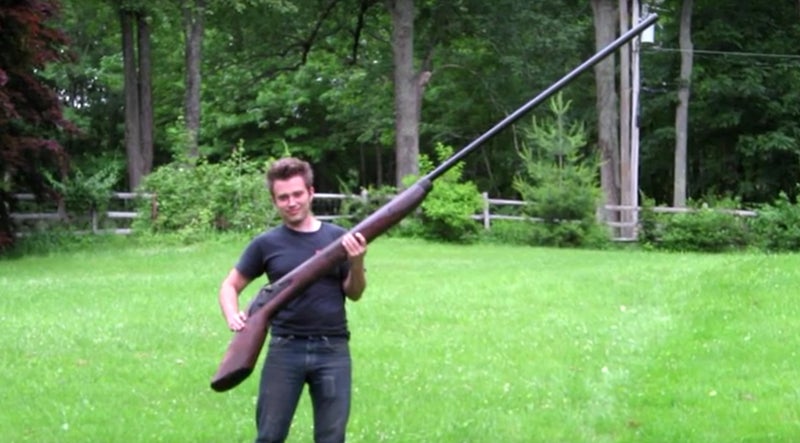I'm open to that... but some Wall Guns and Punt Guns with shoulder stocks are functioally indistinguishable from each other except a wall gun may have a thicker bore wall to accept a solid ball load. Both are very long guns and the long percussion or flintlocks and generally both required two men to load them. Both were smooth bore, both were extremely long and heavy.
Both of them rely on the fact unlike smokeless powder, the more black powder added the longer it will burn, adding pressure and therefore velocity and range to the projectile(s), hence the advantage of the much longer barrels. The wall gun, when loaded with ball, would hit a sheet of paper size target at up to 1000 yards, even without rifling.
The wall guns were more quickly portable than small cannon and in addition to sniper use, could also be loaded with larger shot to repel attackers. Using them with smaller shot was an easy step. The first wall guns even predated the flintlock ignition systems and were fired with matchlock or later wheel lock systems. The first hand held portable guns were wall guns.
The more modern versions were breech loaders and were single user. . . as were those used by punt market hunters.
Wall guns pre-dated punt guns and it is likely the punt guns were originally modified souvenir wall guns brought back by soldiers from India and China, not originally purpose built for market water fowl hunting. Market duck hunters also used the small signal cannons from ships, anything that could fire large amounts of shot on "sitting ducks" that could kill a large number of them with a single shot. I've even read descriptions of market hunters using Winchester 10 Gauge signal cannons, designed only for blanks, being repurposed to shoot actual shot shells, set up around areas where the hunters knew ducks (or pigeons/doves) would congregate and fired simultaneously when the flock was flushed.

Chinese Military Wall Guns
I sold a couple of genuine wall guns on consignment from my gun shop back in the early 70s and they were distinctly marked. One had hallmarks for the East India Company. The other was an obvious cruder native made copy. Both of them matched the guns in the first photo. The East India Company one had military proof marks. I wish I had a photo of it to show you.

Punt Gun with a more typical punt gun stock

12' Long Punt Gun with a more typical punt gun stock
Punt guns did not need to have a shoulder stock. . . I've seen some that were obviously designed to be mounted in the punt. The ones I saw had a knob or a flat boardlike stock designed for some kind of receiver mount, not one made like a shotgun or rifle shoulder stock. Many were semi-permanently mounted in the punt. Those that did have shoulder stocks were certainly not fired from the shoulder in a small punt. This supports the claim they were originally re-purposed wall guns which did have shoulder stocks.
I called those pictured in the original post Jingal wall guns because they had shoulder stocks. It is possible they were used, or even possibly originally made, as Punt guns as well but for the reasons above, Yo-Yo, I stand by my original assessment they are more properly defined as wall guns. . . although looking in more detail at the second photo, the barrel appears to be a tad flared (wall guns would not have a flared barrel), so it may be a true punt gun and probably made as such, even though it appears to have a shoulder stock—that may have just been a traditional look retained though inertial design.
By-the-way, we fired the East India one before we sold it (the other was not in shootable condition). We had to make our own cap to fire it because we could not find a large enough one to fit the nipple commercially available (I estimated it would likely have been a #6 size which no one was making then). The gun was so heavy, about 50 - 60 pounds, that even with a really large load of shot, with 2F black powder, the recoil was more like a fast, heavy push. IIRC, our gunsmith measured the bore to be about 2 bore, ~1.3" in diameter.
We didn't get that much money for either of the wall guns. IIRC, I think the East India Company one was sold for about $500 and the native made one went for about $275. They were a hard item to sell and display. There were very few collectors as they take up too much room. I'd think one would have to store and display it in the garage, as moving it through the house through hallways and into a room would be difficult at best. I knew only one collector who had more than one.
Now, they are going for around $5000 to $7000. . . but most of the buyers are in Europe. Some very rare American Wall Guns go for far more, especially in Flintlock. George Washington had a very few wall guns in the Continental Army which he used quite effectively for sniping.
They are now quite rare in the US, whether wall guns or punt guns. Most of the wall guns were contemporaneously cut down to a shorter, more easily handled length, and the British Military wall guns with "Tower locks" whether in flint or converted to percussion were almost all destroyed in the 1841 armory fire in the Tower of London. The East India Company wall guns exported to India, the native copies, Chinese Jingals, plus various versions that may have been converted to punt guns are much more common.
Have you ever heard vocal impressionist Wes Harrison's "The Great Duck Hunt"? Hilarious!